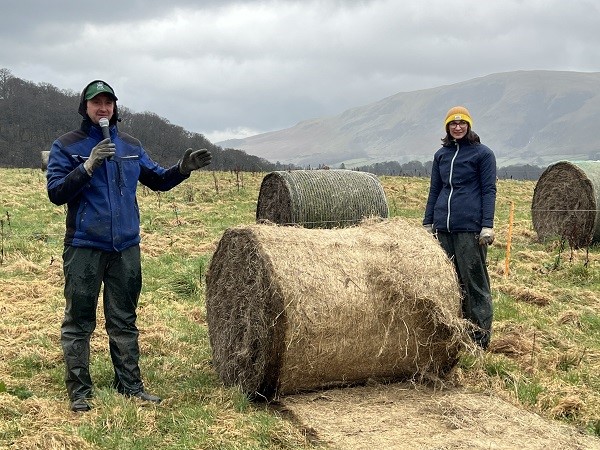Unlocking the benefits of bale grazing
Monday, 25 March 2024
Fifty livestock farmers heard how Claire and Sam Beaumont benefit from bale grazing their out-wintered cattle at a meeting at Gowbarrow Hall Farm on the northern shore of Ullswater last Thursday (14 March).
The meeting was organised by Pasture for Life, AHDB and Innovative Farmers.
The Beaumonts returned to Claire’s 188-ha home farm in 2017 after a spell working in London as engineers.
Finding it hard to make any money with Swaledale sheep, they sold the ewes and bought pedigree beef shorthorn cattle in 2019.
Now they have a herd of 52 animals of varying ages, with the cows calving at the end of April. Sam and Claire are aiming to have 100 head of cattle in the next few years.
The soil is heavy clay and the average annual rainfall is 1,700 mm.
The farm consists of 33 ha of top fell, 430 m above sea level. This is heather moorland and grazed by four fell ponies in summer.
Below this is a 90-ha area of rough grazing and wood pasture, where the herd spends most of the winter on deferred grazing.
On the lowest ground, there are 65 ha of meadows managed on long 60-to-90-day grazing rotations throughout the summer.
The cattle include beef animals targeted for direct sale to local customers. These are Pasture for Life certified, meaning no grain is fed throughout the animals’ lives.
“We are passionate about maintaining the natural landscape and enriching the wildlife in this beautiful place,” says Claire.
“Cattle offer opportunities to do this. We can revitalise the grassland while producing very high-quality food. Using a low-cost system, which includes outwintering, allows us to do this and make a profit.”
In 2021, the plan was for the herd to stay in the wood pasture until the end of March. But by the end of February, the cows were restless and forage analysis showed pasture quality dropping significantly. So Sam and Claire moved the herd to the lower pastures, rotating the animals around behind electric fencing.
But very slow grass growth, in what turned out to be a false spring, meant they soon ran out of fresh forage.
They needed another solution for grazing in March and they tried bale grazing.
In 2023, they set up piped water and electric fencing in one five-hectare field that was not in any stewardship scheme, that had been rested for ten months.
Thirty-two cattle bale grazed it with 34 round bales for 34 days. By 15 June it had recovered, producing more grass than ever before.
In 2024, the field was grazed with the entire herd of 65 in the previous July 2023 and then rested for six months.
Thirty hay bales were made in another field on the farm and moved into place in September. Twenty-four bales of species-rich hay made by Cumbria Wildlife Trust arrived in October, with the hope of increasing the diversity of plant species in the field.
This March, 43 cattle went in on the first day of the month and will stay there until the last day, eating up to two bales a day. Any hay that is not eaten is left to feed the soil.
“I am thinking about what and where the animals will graze all year round, “ Sam explains.
“I work out how much to give and where to place the bales using a free farming app and I move them at between 8:00 and 9:00am every morning.
"It is a fluid and flexible process, which allows us to balance our family life and other commitments.
“Bale grazing strategies differ on different farms. For us it gives the cows something different to eat when the wood pasture has done its job and allows the meadows to get growing.
"It is also good for me – I like the physical activity needed to roll out the bales.”
The Beaumonts are already noticing changes in sward composition with more taller grasses like cocksfoot and more legumes and wildflowers such as red clover, ox-eye daisies and plantains present and soil health improving.
Being part of the four-year Innovative Farmers project ‘How does bale grazing affect forage quality and soil health,’ headed by Nikki Yoxall from Pasture for Life, will test soil and forage after bale grazing to quantify further benefits.
Outwintering has also reduced costs from £375 per head when the cattle were housed down to about £30/head this winter and the cattle are healthier than ever.
Bale grazing has also ‘given’ Sam and Claire the old shed back where they now salt and store hides for leather. They have also set up a Johnson-Su bioreactor for making biologically enhanced compost.
 Pasture for Life
Pasture for Life
 Pasture for Life
Pasture for Life

